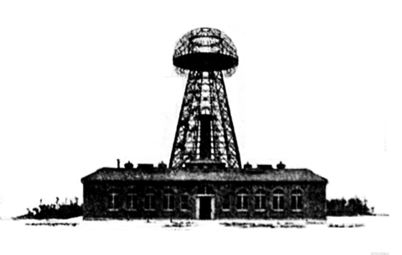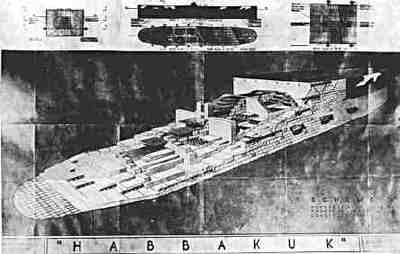10 Real-Life Ideas More Insane than Almost All Science Fiction
Pulp science fiction is full of ill-conceived and improbable ideas, from death rays to undersea metropolises. As much as we enjoy the pulps and the wack-ass ideas and infeasible technology that populate them, it’s obvious none of those ideas could ever get any traction in real life, right? Except that’s not the case. History is full of completely insane ideas, some of them even too far-fetched for the pulpiest story, that received considerable support from the public, investors, learned institutions and even governments.
10) Wireless Power Transmission
Way back in 1904, Nikola Tesla (inventor of alternating current and quasi-mad scientist) proposed a system of wireless power transmission and communication that would span the globe. By the use of some kind of standing wave phenomena only he understood, his system of towers would transmit electrical energy all over the globe, directly to the end user and throughout the home, without wires. He got as far as building a test tower, filing some patents and rounding up some investors, but couldn’t get it operational quickly enough to keep the money men happy, and died before it ever got off the ground. Tinkerers and crackpots to this day are still trying to figure out his notes and get this, and some of his other crazy-ass ideas, working. Looking at the mass of cords behind my entertainment center, I hope they get it figured out soon.
9) Draining the Mediterranean Sea
In the ’20s a visionary engineer named Herman S?rgel came up with a plan to solve Europe’s problems by damming the Mediterranean sea to drain it down enough to lower its level a few hundred meters and expose more than half a million square kilometers of new land for settlement and development, not to mention generate a bunch of electricity via the dams it would require to achieve all of this. This ambitious plan was called Atlantropa and it got an amazing amount of public support and even some consideration by the pre-WWII Weimar Republic government of Germany. He also planned to “make Africa useful” to Europe by building a big-ass inland sea in the middle of it. Both plans were derailed by his death, and by the complete and total insanity and infeasibility.
8) Frozen Aircraft Carriers 
Fed up with the Germans sinking their boats right and left during WWII, the British developed a novel plan to make an unsinkable aircraft carrier out of ice. The thought went that icebergs are strong enough to sink giant ships without suffering much damage, and hell, ice is buoyant, so how could it fail? It turned out that ice was too brittle, and even the ice/wood pulp mixture called Pykrete needed to be reinforced by steel. Plus it was slow, needed a gigantic rudder and, presumably, was cold as fuck to sail on. They did get as far as constructing a scale model in a lake in Canada but Project Habbakuk, as it was called, was eventually given the cold shoulder by the navy.
7) Exploding, Pissed-Off Bats
During WWII, someone decided to take the bats in batshit insane literally and the result was a little plan called Project X-Ray. The idea here was to drop bats equipped with timed incendiary devices over Japan, where they would roost until the incendiaries went off during the day, and burnt Japan’s wood-and-paper buildings to the ground. They got as far as designing the tiny bombs and even running a few tests, one of which set an Army base on fire (whoops, sorry about that!). Ultimately the plan was abandoned for time reasons – they were running out of war, basically — and the fact that the atomic bomb came out and made it look pretty stupid in comparison.
6) Drug-Induced Mind Control
The power to control minds and compel people to do your bidding against their wishes is the dream of supervillains and totalitarian despots everywhere. Naturally then, it’s no surprise that our own government spent a lot of time looking into it. The CIA, aided by some friendly ex-Nazi scientists, spent about 20 years, starting in the early ’50s, researching ways to make you do whatever they wished, under the not-at-all frightening name MK ULTRA. In pursuit of this noble goal, they unwittingly dosed people with powerful hallucinogenic drugs, practiced brainwashing techniques and generally acted like the supervillains they were apparently hoping to become. At least one person died. Luckily they never found anything useful … we hope. Because they destroyed all the evidence in the late ’60s, we’ll never really know, unless we find ourselves acting on a strange, unwitting compulsion to kill someone, or perhaps compulsively drink something foul and unhealthy, like Mountain Dew.
—-
5) Undead Dogs with Other Dog’s Heads
Not to be outdone by the Americans in the race for creepiest, most fucked-up science projects, the Soviets decided to try out their own supervillain-esque research. They chose to try and cheat death itself with a series of disturbing experiments in reanimation and extreme transplants. The Soviet doctor Vladimir Demikhov grafted the head and body of a puppy onto a fully grown mastiff, which lived for six days and totally creeped out everyone that saw it in that time. They also managed to keep a severed dog’s head alive by connecting it to life support machines and brought back a dog from the dead after killing it. Not creepy enough yet? A Dr. Robert White did his own head transplants, with monkeys, right here in the good old U.S. a few years later.
4) Agriculture by Nuke
During the ’60s, scientists looking for peaceful uses for nuclear weapons came up with the absolutely genius idea of using them for cheap, quick, large-scale construction projects. The idea was, why spend all the time and manpower digging out something like the Panama Canal, when you could just blow a ginormous fucking hole in the ground, square off the edges and call it good? A couple of proposed projects included a man-made harbor in Alaska, a canal through Nicaragua, and a water transport way through the California mountains. This brilliant plan went by the name Project Plowshare, and it got as far as a proof of concept testing before the obvious issues – radioactive fallout and contamination, public resistance to having nukes set off nearby to “fix up” the neighborhood – sunk the project.
3) Nuclear Bomb-Fueled Spaceships
If using nukes to dig big-ass holes isn’t crazy enough, how about using them to launch spacecraft? That was the idea behind Project Orion. The plan was to drop a nuclear bomb out the back, detonate it 200 feet behind the ship, absorb the blast using a giant shock absorber and use the reaction to launch a spaceship and fly it through space. Simple, right? The advantage would be we could get to Pluto and back within a yearlong mission, which is cool. The disadvantages were, to put it mildly, significant. Who wants to be a few hundred feet from several dozen nuclear explosions, with nothing but a big, Rube Goldberg-esque shock absorber between you and the bang? Worse, the fallout and EMP generated by a launch would pretty much devastate everything for dozens, if not hundreds, of miles every time the thing took off. Other than that, it was an awesome plan…
2) Spears Dropped from Space
The search for ever more devastating and terror-inducing weaponry marches on to this day and one of the latest schemes involves a plan to drop twenty-foot-long tungsten rods onto targets from orbit. Satellite guided and unpowered, the space spears would reach a speed of about 36,000 feet per second and produce as much damage as a nuke, without the nasty fallout. The plan, informally dubbed Rods from God, is currently in the Pentagon’s wish list (where it probably has a cool, classified name like Project Damocles) and could be operational within a decade. Fun!
1) Let’s Blow Up the Planet and Stay in Big Elevators
In an apparent effort to prove that far fetched, wild-eyed theories still have a place in the world, Swiss architect Christian Waldvogel has proposed destroying the earth and rebuilding it as a hollow sphere via a series of space elevators. While construction occurs, humans and animals and plants will be “stored” in the elevators. He’s written a book about it and entered the book/idea (called Globus Cassus, by the way) in a 2004 architecture exhibition, where it won a gold and proved that there are still plenty of people willing to award crazy ass ideas with dubious honors.


